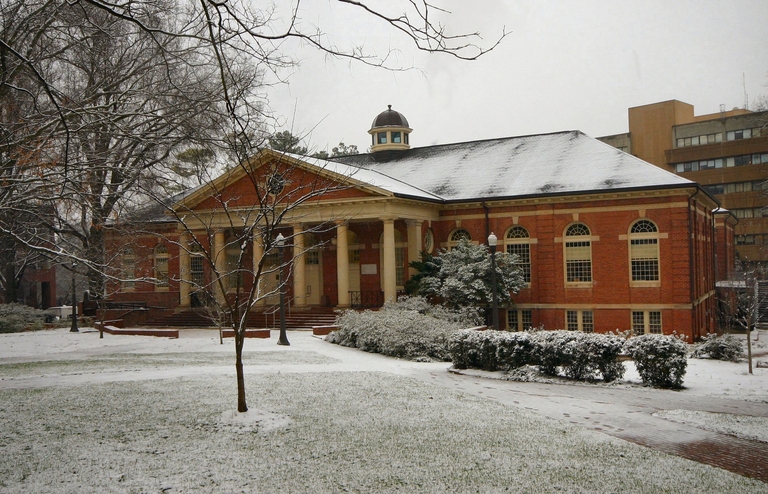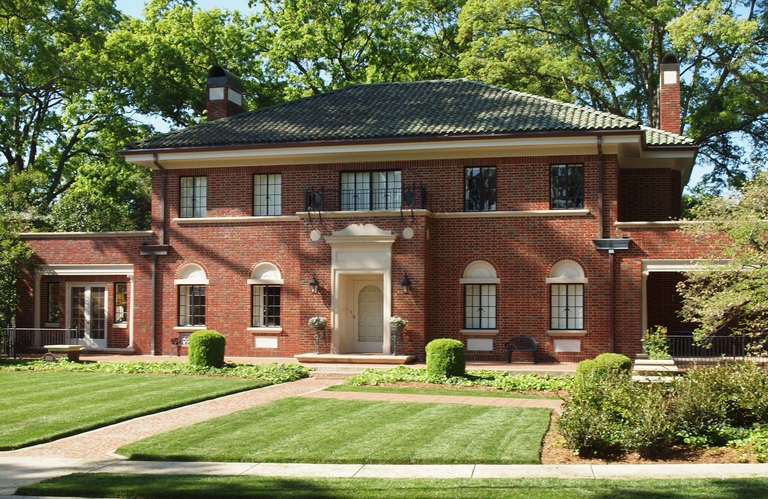Nelson, G. Murray (ca. 1883-after 1940)
Variant Name(s):
Grenville Murray Nelson
Birthplace:
Canada
Residences:
- Raleigh, North Carolina
- Durham, North Carolina
Trades:
- Architect
NC Work Locations:
Building Types:
Styles & Forms:
Beaux-Arts; Georgian Revival; Neoclassical; Tudor Revival
G. Murray Nelson (ca. 1883-after 1940) was a Canadian-born architect who arrived in Raleigh about 1918 or 1919 and became a prominent architect in Raleigh and Durham, first in partnership with James A. Salter (1919-1920) and then with Thomas W. Cooper during the 1920s and early 1930s. He and his partners designed many notable houses, especially for prosperous suburban clients, as well as educational and public buildings chiefly in classically influenced styles.
Little is known of Nelson’s early life and career. The United States Census of 1910 recorded him as Granville M. Nelson, a resident of Queens, New York, an architect who had immigrated into the country in 1905. His household included his wife, Cecile, and daughter Iona, 3, both natives of Canada. When he registered for the United States draft in 1918, he identified himself as Grenville Murray Nelson (b. Nov. 6, 1883), an architect, a British citizen, and a resident of Brooklyn, New York.
Why he moved to Raleigh is unknown; he was first listed in the Raleigh city directory in 1919, as an architect in the firm of James A. Salter and G. Murray Nelson with offices in the Commercial National Bank at 20 E. Martin Street. He resided at 502 N. Blount Street. After Salter returned to solo practice, in 1920 or 1921 Nelson formed Nelson and Cooper with Thomas W. Cooper, a former stonecutter who had been a draftsman in Salter’s office since at least 1915 and in Salter’s and Nelson’s office in 1919. Nelson’s first wife and their daughter must have died: the 1920 United States Census listed him in Raleigh with his wife, Lauretta, born in New York, and daughter Iona, 1 1/2, born in North Carolina.
The Raleigh city directory listed the firm of Nelson and Cooper regularly from 1921 into the early 1930s, and the firm continued to find work during the Great Depression. The partnership seems to have been fluid as well as prolific, for the Raleigh directory often listed the two men individually as well as together, and Nelson also maintained a Durham office listed at 123 Main Street in the Durham city directory. A set of blueprints dated 1931 names the firm as Nelson and Cooper of Raleigh and Durham. The firm’s stylish residences concentrated in the growing suburbs of Raleigh and Durham. Like such examples as the Thomas Ruffin House, the Julian Rand House, and the William Proctor House in Raleigh’s fashionable Hayes Barton suburb, most of these were in Georgian Revival and other classically detailed modes.
Nelson and Cooper also planned institutional buildings in a neoclassical vocabulary. Their State Agriculture Building, a stone-faced edifice, like others around Raleigh’s Union Square, displays Beaux-Arts ideals in its response to the North Carolina State Capitol. Planning for it began during Salter’s tenure as State Architect, and it was completed under the name of Nelson and Cooper. The firm also produced designs for present North Carolina State University, including Ricks Hall and an addition for Leazar Hall. Farther afield, the Manufacturers’ Record of May 25, 1922 noted that Cullowhee Normal and Industrial School (now Western Carolina University) in Jackson County was to erect a brick dormitory with Spanish tile roof and ornamental terra cotta designed by Nelson and Cooper, with H. A. Underwood as engineer; it has not been further identified.
Nelson designed several major residences in Durham, including some for faculty at the Duke University Hospital and Medical School. The J. Deryl Hart House, for example, built on Duke University Drive for a founding chairman of the medical school, displays a Tudor Revival style in keeping with the Gothic Revival style of the West Campus (see Julian Abele); this residence is variously credited to Nelson and Cooper and Nelson alone. A few other Durham houses have been attributed to Nelson or Nelson and Cooper including the Thomas A. Stokes House (1931, 506 E. Forest Hills Blvd.) and the Kronhimer House (1924, 1015 Minerva Ave.). In 1940 the census listed Grenville M. Nelson as a widower and an architect in Raleigh and noted that in 1935 he had resided in Durham. His career thereafter and his death date have not been determined.
(Note: Some accounts show Nelson and Cooper as architects for buildings constructed in the 1910s, but Raleigh city directories show that Nelson was not in Raleigh before 1918 nor was he associated with Cooper until 1920 or 1921.)
- Durham City Directory, various issues.
- News and Observer, Feb. 13, 1921.
- Raleigh City Directory, various issues.
- Claudia P. Roberts (Brown) and Diane E. Lea, The Durham Architectural and Historic Inventory (1982).
- United States Censuses.
First Vanguard (Presbyterian) Church
Contributors:James A. Davidson, builder; G. Murray Nelson, architectDates:1925
Location:Raleigh, Wake CountyStreet Address:Corner of Swain and Martin Sts.
Status:No longer standing
Type:Religious
Note:Davidson and Jones Archives; News and Observer, July 6, 1925.
Gilmer's Department Store
Contributors:G. Murray Nelson, architect; James A. Salter, architect; Salter and Nelson, architectsDates:1920s
Location:Raleigh, Wake CountyStreet Address:Fayetteville St., Raleigh, NC
Status:No longer standing
Type:Commercial
J. A. Cooper House
Contributors:G. Murray Nelson, architectDates:1925
Location:Henderson, Vance CountyStreet Address:272 Gholson Ave., Henderson, NC
Status:Standing
Type:Residential
Note:The formal, red brick Georgian Revival residence was commissioned by the owners of the Henderson and Harriet Cotton Mills in Vance County and shows the architect’s mastery of the traditional style popular among prosperous North Carolina citizens of the period. The plans, which survive, are dated 1925 and the house was occupied by 1929.
J. Deryl Hart House
Contributors:Thomas Wright Cooper, architect; George W. Kane, builder; Nelson and Cooper, architects; G. Murray Nelson, architectDates:1934
Location:Durham, Durham CountyStreet Address:2324 Duke University Rd., Durham, NC
Status:Standing
Type:Residential
Note:Dr. Hart came to Duke as head of surgery and later became president of Duke University. In recent years the large Tudor Revival residence has been the home of Duke President Richard Brodhead. The architect for the house has been identified both as Nelson and Cooper and Nelson alone. Records of its construction are in Dr. Hart’s papers at Duke University.
Julian Rand House
Contributors:Coffey Family, contractors; John N. Coffey, contractor; John W. Coffey, contractor; John W. Coffey and Son, contractors; Thomas Wright Cooper, architect; G. Murray Nelson, architect; Howard E. Satterfield, builderDates:Ca. 1931
Location:Raleigh, Wake CountyStreet Address:1544 Carr St., Raleigh, NC
Status:Standing
Type:Residential
Note:The architects and builder of this classic 2-story, red brick Georgian Revival house are cited in the Hayes Barton National Register nomination. A Julian Rand project is cited in the Satterfield building list. Julian and Lillian Rand, longtime residents of Ferndell Lane (near Maiden Lane and State College) first appeared at 1544 Carr Street house in the 1932 city directory.
Leazar Hall
Contributors:Thomas Wright Cooper, architect (ca. 1922); Harry P. S. Keller, architect (1912); Nelson and Cooper, architects (ca. 1922); G. Murray Nelson, architect (ca. 1922); Northup and O'Brien, architects (1947); Ross Edward Shumaker, architect (1945)Dates:1912; ca. 1922 [additions]; 1945 [additions]; 1947 [additions]
Location:Raleigh, Wake CountyStreet Address:North Carolina State University Campus, Raleigh, NC
Status:Standing
Type:Educational
Images Published In:Burton F. Beers and Murray Scott Downs, North Carolina State University: A Pictorial History (1986).
Facility Coordinators, http://www.ncsu.edu/facilities/buildings/.
Marguerite E. Schumann, Strolling at State: A Walking Guide to North Carolina State University (1973).Note:Ross Edward Shumaker designed the building’s east balconies.
Pullen Memorial Baptist Church
Contributors:James A. Davidson, builder; G. Murray Nelson, architect; Thomas Wright Cooper, architect; Nelson and Cooper, architectsDates:1923
Location:Raleigh, Wake CountyStreet Address:1801 Hillsborough St.
Status:Standing
Type:Religious
Note:Pullen Memorial Baptist Church is a fully developed example of Romanesque Revival church architecture, rare in the state and notable for its strong massing and intricate brickwork. The congregation had met in a mission church at the south end of Fayetteville Street in central Raleigh for several years, but after that church burned, the congregation moved to this location near present North Carolina State University in west Raleigh. Aimed at the students at the college as well as other citizens, the $65,000 structure was built with more than 40 Sunday school rooms. Source: Davidson and Jones Archives; News & Observer, Jan. 1, 1922. This issue of the News and Observer carried a lengthy story about the proposed church and its architects (though not the builder) and featured a large drawing of it.
Ricks Hall
Contributors:Dates:Ca. 1922
Location:Raleigh, Wake CountyStreet Address:North Carolina State University Campus, Raleigh, NC
Status:Standing
Type:Educational
Images Published In:Marguerite E. Schumann, Strolling at State: A Walking Guide to North Carolina State University (1973).
State Agriculture Building
Contributors:Thomas Wright Cooper, architect; Nelson and Cooper, architects; G. Murray Nelson, architect; James A. Salter, preliminary architect; John E. Beaman, contractorDates:1922-1923
Location:Raleigh, Wake CountyStreet Address:2 W. Edenton St., Raleigh, NC
Status:Standing
Type:Public
Thomas Ruffin House
Contributors:Thomas Wright Cooper, architect; Nelson and Cooper, architects; G. Murray Nelson, architect; James A. Davidson, builderDates:Mid-1920s
Location:Raleigh, Wake CountyStreet Address:1001 Harvey St.
Status:Standing
Type:Residential
Note:Source: Davidson and Jones Archives, private collection
W. P. Budd House
Contributors:George W. Kane, builder; G. Murray Nelson, architectDates:1924/1934
Location:Durham, Durham CountyStreet Address:903 S. Duke St., Durham, NC
Status:Standing
Type:Residential
Images Published In:Claudia P. Roberts (Brown) and Diane E. Lea, The Durham Architectural and Historic Inventory (1982).
Note:The large Tudor Revival style residence, an early project of major Durham builder George W. Kane, is a landmark of the Morehead Hill neighborhood. It is variously dated 1924 and 1934.
Wiley Forbus House
Contributors:G. Murray Nelson, architectDates:1930-1933
Location:Durham, Durham CountyStreet Address:3309 Devon Rd., Durham, NC
Status:Standing
Type:Residential
Images Published In:Claudia P. Roberts (Brown) and Diane E. Lea, The Durham Architectural and Historic Inventory (1982).
Note:The complex and picturesque “Norman Revival” residence is among the most notable houses in Durham’s distinguished Hope Valley suburb. Designed in 1930 for the head of the Pathology Department at Duke Hospital, it was completed in 1931, then burned sixteen months later, and was rebuilt with only slight interior changes.
William Proctor House
Contributors:Coffey Family, contractors; John W. Coffey, contractor; Thomas Wright Cooper, architect; Nelson and Cooper, architects; G. Murray Nelson, architectDates:1932
Location:Raleigh, Wake CountyStreet Address:1521 Jarvis St., Raleigh, NC
Status:Standing
Type:Residential
Images Published In:Houses By Coffey, Charlotte Vestal Brown Papers, Special Collections Research Center, North Carolina State University Libraries, Raleigh, North Carolina.




